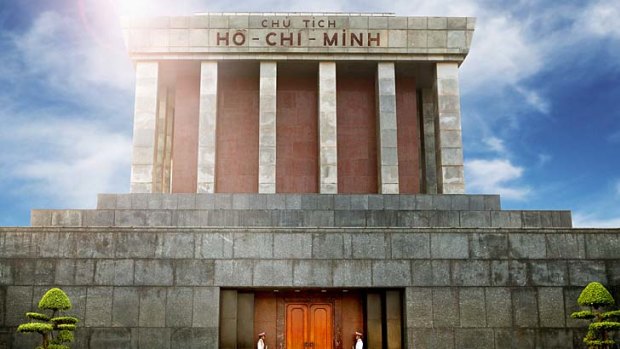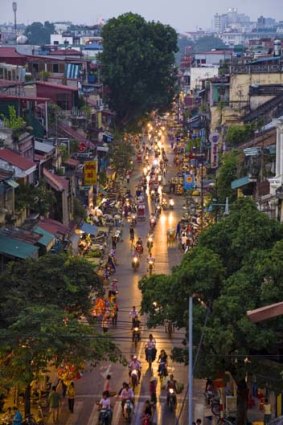This was published 12 years ago
Twenty reasons to visit Hanoi
From art to food, history and spas, Lance Richardson's 20 reasons to visit Hanoi.

Repressive force ... the Ho Chi Minh Mausoleum.Credit: Getty Images
1 Motorbikes in the Old Quarter
The Hanoi traffic is an alarming introduction to the Vietnamese capital, though locals are acclimatised to the chaos. Visitors should be wary of hiring a motorbike straight off the plane - instead, jump on the back of a taxi bike for a thrilling tour through the Old Quarter and a crash-course in road rules (what rules?). A good rule of thumb: when you can walk across the street without flinching, only then is it time to contemplate a rental.
2 Propaganda art

Motorbikes in the Old Quarter, Hanoi.Credit: Getty Images
Guns, women on tractors, Ho Chi Minh, the white lotus - whether you find it quaint or menacing, Vietnamese propaganda has a small but striking palette of iconography. Since the end of the "American War" (as the Vietnamese call it), a curious industry has emerged aimed at marketing defiant posters to the very people they rally against. Thus shops like Pham Manh Gallery on Dinh Liet are filled with English translations under expensive reproductions: "The empire and international reactionaries shouldn't be unwise to touch this country." Some things are lost in translation.
3 Museum of the Revolution
More propaganda can be found in the fascinating Museum of the Revolution on Tong Dan Street. Charting liberation movements from 1858 to 1945, there's next to no explanations accompanying anything. But the assorted objects offer a curious window onto an alternative reading of significant 20th-century events, including a small padlock supposedly used by Australian workers to lock the parliament building in support of the Vietnamese revolutionary movement.
4 Hoa Lo Prison
The infamous "Hanoi Hilton" - dubbed thus by American prisoners during the Vietnam War - was constructed by the French in 1896 over the top of Phu Khanh village. Its history is long and grisly, only selectively recounted (in line with propaganda objectives) in the several rooms that remain of what was once a much larger site. Cells occupied by life-like shackled mannequins are particularly evocative; the soundtrack accompanying a guillotine and a grandiose shrine to "patriotic prisoners" less so. Like the Museum of the Revolution, a full understanding of what happened here requires additional reading.
5 Ho Chi Minh Mausoleum
To experience the Ho Chi Minh Mausoleum is to experience the full repressive force of the communist apparatus. No talking, hands in pockets, or intimations of disrespect. The body of Ho Chi Minh, the beloved Vietminh leader who led the independence movement, is preserved under eerie orange lighting in a glass coffin. Visitors flow around his granite tomb in two tightly controlled lines - except in October and November, when Ho heads to Russia for an annual touch-up.
6 Ho Chi Minh Museum
The weirdness continues next door in the under-appreciated Ho Chi Minh Museum, an enormous white building intended to evoke the iconic lotus flower. Much has been written about its baffling exhibits - the cave intended to represent Ho's brain; a car crashing through a wall, representing American aggression - but the ham-fisted curation has a certain charm. What does the giant papier mache fruit represent? This is a museum that really makes you think.
7 Street food
Besides the motorbikes, few things define Vietnam like the food. To visit the country without hunkering down on a footstool for a bowl of "pho ga" (chicken noodle soup) is like visiting Italy and abstaining from pasta. There are plenty of restaurants aimed at tourists in Hanoi - skip them. Find a vendor on the footpath and follow three rules. Choose from the food you can see, not from a menu. Offer a fixed amount of money before asking for the price, thereby heading off the inevitable overcharge. Follow your stomach's intuition: if in doubt (hygiene-wise), leave it out.
8 The French influence
The French colonialists left more than an infamous prison and several guillotines: they left a Vietnamese baking culture that has, over the years, permeated Australia through its immigrant communities. Numerous bakeries in the Old Quarter sell a familiar line-up of almond bread and baguettes (and the famous "Vietnamese sandwich"). For interest, compare these offerings to traditional pastries called "banh", which are glutinous rice mixed with various savoury ingredients, wrapped in leaves and boiled in a square or moon shape.
9 Snake village
For the more adventurous gourmands, a short drive out to Le Mat, the "snake village", delivers an unforgettable meal. Choose an attractive snake, haggle a price, then sit quietly as your selection is flayed at the table, its blood and bile dripped into shot glasses filled with rice wine. Men should swallow the heart (for virility). When the dishes arrive, chew very slowly (for snake bones). Yes, it tastes like chicken. A good choice is Trong Khach. trongkhach.com.vn.
10 Tea, coffee and rice wine
There is so much liquid in Vietnamese food it sometimes seems like locals never need to drink but these three exceptions can be found nearly everywhere. Tea is particularly popular, with lotus tea a specialty. Coffee comes in several types, with "Ca phe da" a delicious shot over sweetened condensed milk, often served with ice. Rice wine, with an alcohol content of 18 per cent to 25 per cent, should be treated more like vodka. It is impolite to refuse if you are a dinner guest. Or a breakfast guest, actually.
11 Hoan Kiem Lake
The heart of the Old Quarter is Hoan Kiem Lake, which, despite its toxic green colour, offers a pleasant respite for pedestrians from the frantic game of Frogger that constitutes the rest of the traffic-heavy area. The 18th-century Ngoc Son Temple, on Jade Island, can be reached via the beautiful Huc Bridge but another lesser-known haven is Balcony Bar, overlooking the lake from its first-floor nest of fairy lights on Le Thai To Street.
12 Water Puppets
Seen in their original setting of 11th-century villages around the Red River Delta, "the puppets that dance on water" would have seemed a spectacular and magical display of human ingenuity. In the tiered theatre on the edge of Hoan Kiem Lake, the musicians and puppeteers look bored and slightly bemused by the modern addition of fog machines. A final sequence, in which a carp is transformed into a graceful dragon, makes it worth the $3 admission fee, though. thanglongwaterpuppet.org.
13 Temple of Literature
Vietnam's first university and a monument to scholars, the Temple of Literature was built in 1076 and is featured on the back of the 100,000-dong banknote ($4.50). Though it has been reconstructed numerous times over the centuries, the Confucian mainstay preserves a classic architectural style with a citadel, courtyards and large lake. It remains one of Vietnam's most popular historical sights.
14 Spa treatments
Small massage shops are sprinkled everywhere through Hanoi but several more comprehensive spa centres offer a range of treatments at rates that make Australian prices seem extortionate by comparison. La Siesta Spa, for example, offers 3½-hour packages, including a facial and body scrub, for $US135 ($127). A free gift, green tea and rejuvenating pho round out the experience. zenspa.vn.
15 National Tuong Theatre
A government company founded in 1959 and situated in the Old Quarter, the Tuong Theatre aims to preserve traditional styles of acting, dancing and music, such as Nha Nhac, a musical genre designated Intangible Cultural Heritage by UNESCO in 2003. The theatre offers performances every Thursday and Friday night, combining five scenes from Tuong plays (with English subtitles). vietnamtuongtheatre.com.
16 Vietnam Women's Museum
An unexpected gem, this recently renovated institution examines Vietnam through the lens of its female population, including their war efforts, participation in the struggle for independence, marriage customs and traditional dress. One notable exhibition features photographs taken by poor Hanoi street vendors, trained to use a camera so they could document the process of setting up businesses in the Soc Son district (with funding from the Finnish embassy). Pair it with a visit to the Museum of Ethnology. womenmuseum.org.vn, vme.org.vn.
17 Shopping
Everything in Asia is cheaper, right? It depends. "Non la" (conical hats) and army caps with the iconic red star are affordable souvenirs and fakes are everywhere. For genuine Levis, Adidas, Gucci or North Face, however, prices aren't significantly different to those in Europe and Australia. For the real deal, try the Cho Hang Da market. For Apple products, try virtually any street. Be aware: despite their signs and stainless-steel facades, Apple stores are rarely "authorised" dealers, though it's hard to fake an iPhone.
18 Night markets
Just when you think the Old Quarter couldn't possibly hold any more stuff, it surrenders Hang Giay and Hang Dao streets to a seemingly infinite line of illuminated orange stalls every Friday and Saturday night. Much of the material on sale is an extension of the surrounding shops but the festive atmosphere is infectious. Think wallets, Buddhas, plush buttons and wall lights shaped like teapots. You can even find greetings cards with a pop-up Sydney Opera House.
19 Karaoke
Karaoke may have originated in Japan but its blend of shamelessness and self-abandon is universal in appeal. It seems like every moderately sized city in Vietnam has its fair share of karaoke parlours, even if the government considered a karaoke dancing ban in 2009 (linking it with drugs and prostitution). In Hanoi, try Cua Dong Street in the Old Quarter. Be careful of hidden costs, though, and ask for a room inspection before agreeing to pick up the microphone. If in doubt, watch the professionals sing at Minh's Jazz Club instead. minhjazzvietnam.com.
20 Sleeper trains to Lao Cai
When the urban jungle of Hanoi proves too exhausting, a good salve can be found in the form of an overnight sleeper train heading north to Lao Cai, gateway to Sapa and its indigenous mountain villages. Each carriage on the train functions as an independent company, with differing levels of quality and service. Prepare for a bumpy ride but the destination is worth the trip. traintosapa.com.
Sign up for the Traveller Deals newsletter
Get exclusive travel deals delivered straight to your inbox. Sign up now.